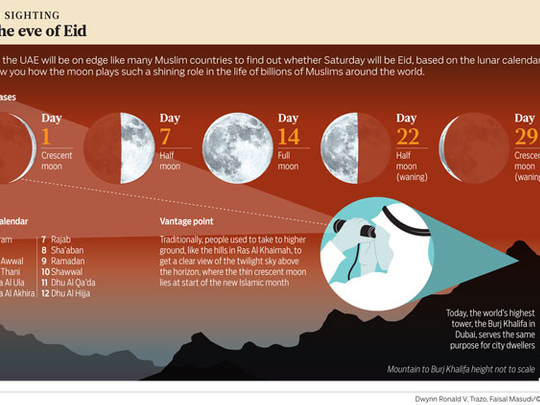
Dubai: UAE residents will be on edge Friday night to find out if the Eid holidays start on Saturday.
If the crescent moon is sighted anytime after sunset, Eid will start Saturday in line with the Islamic lunar calendar.
So, what’s different about the Islamic months and why does the moon play such a shining role in the lives of countless Muslims around the world?
The tradition of moon sighting has stood for 14 centuries since the birth of Islam.
In fact, the waxing and waning of the moon — the visible part of the moon made so by sunlight spreading across its surface — has been used since ancient times to keep track of time.
“This moon or lunar calendar’s been there forever, it predates Islam. Anyone can use it. You just look at the moon and know what day of the month it is,” said Hasan Al Hariri from the Dubai Astronomy Club.
“The moon has clear fixed phases — from the crescent moon, to half moon, to full moon and back to crescent — that makes it easy to follow. So, you know what day and month it is, but what about the year?
“[In the corresponding year 622 AD] it was fixed as ‘Year One’ of the Islamic calendar, also called Hijri to mark the emigration of Prophet Muhammad, peace be upon him, from Makkah to Madinah.”
We are now in year 1433 in the Hijri or Islamic calendar, and today (Friday) could be the last day of Ramadan.
Each of the 12 lunar Muslim months is either 29 or 30 days, as the moon’s orbit around the earth is about 28.5 days, he explained. It takes about another 24 hours to be able to see with the naked eye — the faint crescent of the new moon traditionally marking the new month.
Since the month is at least 29 days then, people look for the crescent on the night of the 30th.
If it is seen — usually in the fading twilight after sunset — the current month ends with 29 days ‘hollow’ and the next month starts.
If it is not seen — or if it is too cloudy — the current month is regarded as ‘full’, that is 30 days. This framework means the Islamic year ends up being 354 or 355 days long, compared to the regular 365-day solar year.
This made moon sighting essential for religious ceremonies — and for legal reasons like quantifying the duration of contracts and loans — and so it was done for every month. However, these days — apart from Ramadan and the Eid following it immediately — the start and end of the months are mostly based on calendar dates set in advance in scientific timetables.
“You can know to the minute when the moon will rise or set on a particular day five years down the line, for example. The moon has a fixed predictable orbit and cycle, you just work out those times in advance based on current stations,” said Noor Al Haq from Dubai’s Department of Islamic Affairs and Charitable Activities.
“Traditionally, moon sighting has been done with the naked eye, without the use of special equipment. There‘s no dispute among the religious scholars and astronomers about it, they both are specialists in their own field. It’s only the common people who don’t fully understand the logic behind these two specialities that argue over moon sighting or calculations.”
Al Haq pointed out moon sighting has its own talent, depending on the observers’ location relative to the moon, their eyesight, the weather, the height of the observation point, knowledge of where and when to look for it in the sky, among other technicalities.
“People used to take to higher ground to get a clear view of the horizon, from places like hilltops in Ras Al Khaimah. Today, some people do this from Burj Khalifa, the world’s tallest tower, in Dubai,” Al Haq said.












